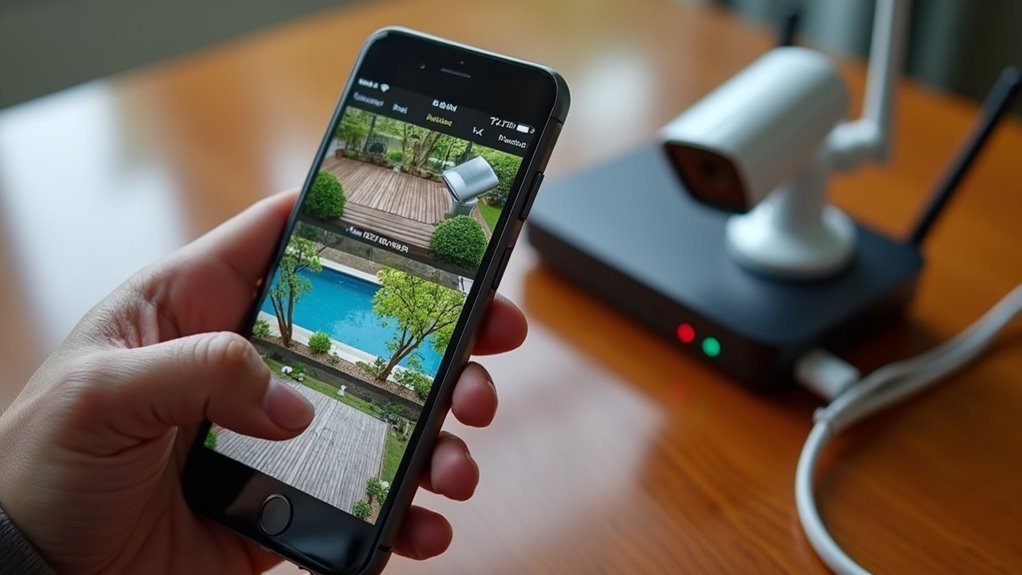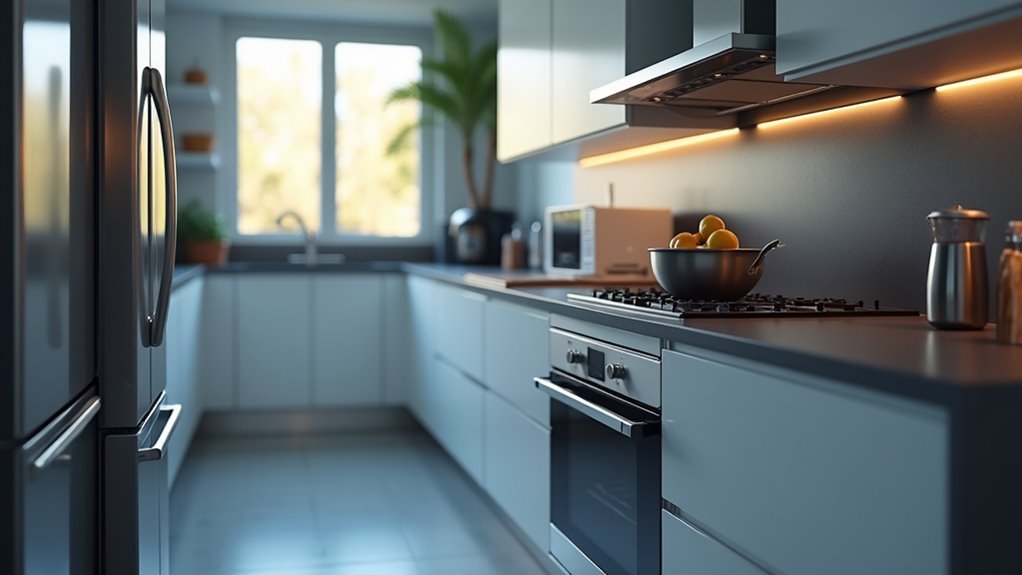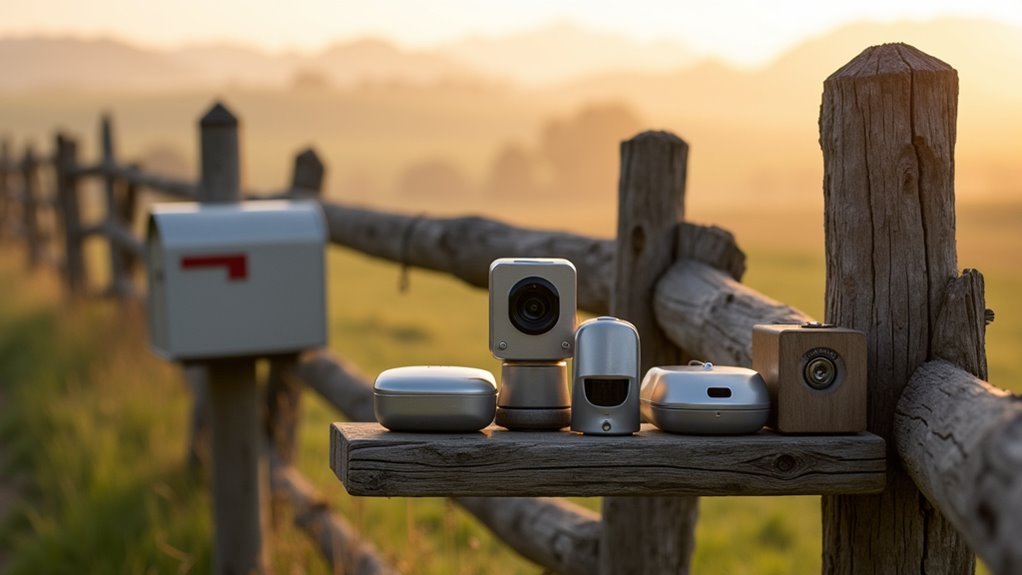You’ve probably wondered if connecting your Z-Wave devices to Home Assistant is worth the effort. While proprietary hubs promise plug-and-play convenience, they’re limiting your smart home’s true potential. Home Assistant transforms your Z-Wave network into something far more powerful than manufacturer-specific apps ever could. The difference between basic device control and sophisticated home automation becomes clear once you understand what’s possible when these technologies work together.
Enhanced Device Compatibility and Interoperability

When you connect Z-Wave devices to Home Assistant, you’re tapping into a standardized protocol that guarantees seamless compatibility across manufacturers and creates true interoperability within your smart home ecosystem.
This integration enables devices from different brands to communicate effortlessly, eliminating compatibility concerns that often plague smart home setups.
With over 1.7 million Z-Wave devices currently available, you’ll have access to an extensive catalog of compatible products for diverse automation scenarios.
The vast Z-Wave ecosystem offers 1.7 million compatible devices, providing endless possibilities for customized smart home automation across every room and function.
Whether you’re combining door sensors from one manufacturer with smart switches from another, Home Assistant guarantees they work together harmoniously.
This interoperability transforms your smart home into a unified system where every device speaks the same language, enabling sophisticated automation routines that span multiple brands and device types seamlessly.
Centralized Smart Home Management
Beyond device compatibility, Home Assistant transforms your Z-Wave network into a unified command center where you’ll manage every connected device from one complete interface.
This centralized platform eliminates the need to juggle multiple apps or hubs, streamlining your smart home experience considerably.
You’ll create sophisticated automation routines that connect Z-Wave devices seamlessly, enabling scenarios where your motion sensors trigger lights, locks, and thermostats simultaneously.
The platform’s device management capabilities let you organize equipment by rooms and areas, making control intuitive and efficient.
Real-time monitoring keeps you informed about device status and performance, while the interoperability features allow different manufacturers’ products to work together harmoniously.
Home Assistant’s extensive approach turns your fragmented Z-Wave ecosystem into a cohesive, intelligent smart home system.
Local Communication for Improved Privacy and Security

While most smart home platforms funnel your data through distant cloud servers, Z-Wave devices communicate locally within your home network, giving you unprecedented control over your privacy and security.
Z-Wave’s sub-GHz frequency enables this local communication approach, while Home Assistant serves as your private command center.
Here’s how this combination protects you:
- Encrypted communication through S2 security prevents eavesdropping and unauthorized access
- Mesh networking allows devices to talk directly without internet involvement
- Local communication keeps your data within your home network, away from third-party servers
- Privacy protection eliminates data exposure risks associated with cloud-based systems
- Complete control over your smart home environment without external interference
You’ll maintain full autonomy over your devices while enjoying robust security measures that keep your personal information exactly where it belongs—in your home.
Extended Range and Network Reliability
You’ll find Z-Wave’s sub-GHz frequency operation provides considerably longer range than Wi-Fi, making it perfect for covering large homes without signal dropouts.
Your mains-powered Z-Wave devices automatically function as repeaters, creating a self-healing mesh network that strengthens as you add more devices.
This mesh topology guarantees your smart home stays connected even when individual devices go offline, delivering the reliability you need for critical automation tasks.
Sub-GHz Frequency Advantages
One of Z-Wave’s most significant technical advantages stems from its use of sub-GHz frequencies—typically 908.42 MHz in the U.S. and 868.42 MHz in Europe.
This frequency choice delivers superior performance for home automation compared to higher frequency alternatives.
You’ll experience these key benefits with Z-Wave certified devices:
- Better wall penetration – Sub-GHz signals travel through walls and obstacles more effectively than 2.4 GHz Wi-Fi
- Longer range coverage – Communication distances often exceed 100 meters in open spaces
- Reduced interference – Avoids congestion from microwaves, cordless phones, and other 2.4 GHz devices
- Enhanced mesh topology – Lower frequency enables more reliable connections between repeating devices
- Stable network performance – Less susceptible to household interference guarantees consistent smart home operation
Mesh Network Benefits
Beyond these frequency advantages, Z-Wave’s mesh network architecture amplifies these benefits by creating an intelligent web of interconnected devices throughout your home.
Each mains-powered Z-Wave device acts as a repeater, extending signal strength and improving network coverage far beyond your controller’s initial range. This mesh structure enables communication to bypass obstacles and interference, ensuring reliable connections even through thick walls or across large spaces.
As you add more Z-Wave devices, your network becomes stronger and more capable. The self-healing nature automatically reroutes signals through alternative paths when devices go offline, maintaining consistent communication without manual intervention.
This intelligent reliability means you’ll experience fewer connection drops and improved performance across your entire smart home ecosystem, making Z-Wave an ideal foundation for Home Assistant automation.
Repeater Node Performance
When strategically positioned throughout your home, mains-powered Z-Wave devices transform into powerful repeater nodes that dramatically extend your network’s reach and eliminate frustrating dead zones.
These repeaters boost your Z-Wave network’s communication range while enhancing overall network reliability through intelligent mesh routing.
Your repeater performance benefits include:
- Extended coverage – Each repeater node eliminates dead zones and extends communication range throughout multi-story homes
- Superior wall penetration – Sub-GHz frequency provides better performance through obstacles compared to Wi-Fi protocols
- Scalable capacity – Support up to 232 devices without signal interference or data transmission issues
- Intelligent routing – Automatic path optimization guarantees reliable device communication
- Home Assistant optimization – Monitor and manage network routes for peak repeater performance and efficient data transmission
Advanced Automation and Scene Control
As you dive deeper into Z-Wave integration with Home Assistant, you’ll discover that advanced automation and scene control transform your smart home from a collection of individual devices into a cohesive, intelligent system.
You can automate things based on specific triggers like motion detection or temperature changes, enhancing security and energy efficiency. The mesh networking capabilities guarantee reliable communication over greater distances, while low-latency communication provides real-time responses when conditions are met.
You’ll create complex scenes controlling multiple devices simultaneously—turning off lights and locking doors when leaving home.
Home Assistant’s customization features let you automate everyday tasks using conditions and actions. The centralized dashboard streamlines scene management, giving you complete control over your smart home environment through advanced automation that responds intelligently to your lifestyle patterns.
Real-time Monitoring and Device Status Updates

Once your Z-Wave devices integrate with Home Assistant, you’ll gain instant visibility into every connected component throughout your home.
This real-time monitoring transforms how you interact with your smart devices, delivering immediate device status updates that keep you informed about every change in your environment.
Z-Wave integration with Home Assistant provides several monitoring advantages:
- Instant notifications when doors open, windows open, or motion detectors trigger
- Automated alerts for security breaches, temperature fluctuations, or device malfunctions
- Detailed telemetry data showing battery levels, signal strength, and performance metrics
- Historical tracking that reveals usage patterns and optimization opportunities
- Centralized dashboard displaying all device statuses simultaneously
This thorough monitoring enhances home security while enabling data-driven decisions about your automation setup.
Cost-effective Alternative to Proprietary Hubs
While proprietary hubs often drain your budget through expensive hardware and recurring subscription fees, Home Assistant offers a compelling cost-effective alternative for Z-Wave integration. You’ll eliminate ongoing subscription costs while leveraging your existing infrastructure for smart home automation.
| Cost Factor | Proprietary Hubs | Home Assistant |
|---|---|---|
| Initial Hardware | $150-$400+ | $35-$100 |
| Monthly Fees | $10-$25/month | $0 |
| Device Compatibility | Limited brands | Universal support |
| Annual Cost | $270-$700+ | One-time setup |
| Feature Updates | Subscription-locked | Free community-driven |
Home Assistant’s open-source nature guarantees you’re not locked into specific manufacturers’ ecosystems. You’ll enjoy broader device compatibility across Z-Wave devices without paying premium prices. The platform’s community-driven improvements continuously enhance functionality, making it an intelligent financial choice for long-term smart home automation.
Future-Proof Integration With Open Standards
Beyond immediate cost savings, Home Assistant’s Z-Wave integration positions your smart home for long-term success through its commitment to open standards.
Open standards and Z-Wave integration ensure your smart home investment remains future-proof and adaptable as technology continues evolving.
You’ll benefit from interoperability across manufacturers, ensuring your Z-Wave devices work seamlessly together regardless of brand.
- Wide compatibility: Choose from 1.7 million certified Z-Wave devices across hundreds of manufacturers
- Future-proofing: Open standards mean your investment won’t become obsolete with proprietary changes
- Easy expansion: Add new devices without worrying about compatibility issues
- SmartStart feature: Scan QR codes to add devices instantly without manual activation
- Home Assistant OS evolution: Regular updates enhance Z-Wave integration capabilities
This approach protects your investment while maximizing flexibility.
You’re not locked into one ecosystem, giving you freedom to adapt as technology evolves.
Frequently Asked Questions
How to Use Z-Wave Devices With Home Assistant?
You’ll need a supported Z-Wave controller and running Z-Wave JS server. Connect your dongle, install the Z-Wave JS integration through Settings > Devices & services, then add devices using SmartStart inclusion.
What Are the Downsides of Z-Wave?
You’ll face interference from baby monitors and wireless cameras, need mains-powered repeaters for larger homes, deal with slower response times, experience fewer firmware updates, and pay higher costs due to proprietary licensing.
Is Z-Wave Going Away?
Z-Wave isn’t going away. You’ll find it’s evolving with 1.7 million devices in use, Alliance support as an SDO, and Home Assistant’s active promotion. Its sub-GHz advantage and manufacturer collaboration guarantee continued relevance.
What Is Z-Wave Devices?
Z-Wave devices are wireless smart home products that communicate using sub-GHz frequencies. You’ll find over 3,000 certified devices including sensors, switches, locks, and lighting that work together reliably.





Leave a Reply